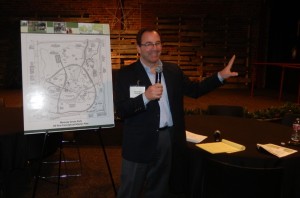
The Tulare County Board of Supervisors invited members of the community to participate in a workshop on December 10 at Café 210. The focus of the workshop was to present and gather public input on the county’s 20-year Master Plan for Mooney Grove Park. This was the second of two meetings seeking input. The first outreach meeting was held on November 6. The board of supervisors’ final consideration of the plan is anticipated to occur in January.
During the first outreach meeting, copies of the plan were available at various workstations for review by the public. Comment cards were distributed so attendees could provide feedback on the plan and its recommendations. All of the comments that were received by the county at the first meeting were summarized and presented for discussion.
After the public had a chance to look over the documents and maps, Jason Paul, principal geologist of Kleinfelder, explained that, for now, the plan is conceptual, meaning that there has been no California Environmental Quality Act (CEQA) review nor have any estimates for work been sought. The plan was initiated by the county to aid in landing a $1.45 million grant to build the new History of Farm Labor and Agricultural Museum. The purpose, now that the museum is built, is to move forward in preserving the park. Through a collaborative effort between Kleinfelder and the county, a plan was put together that will enhance the public’s experience of the park. Because Mooney Grove has a limited budget for minimal maintenance, the layout and design was also made with an eye toward qualifying for public funding.
Dan Veyna, a landscape architect, gave the attendees a bit of history of the park. A hundred years ago, the original landscape architect for Mooney Grove was the same person who designed Roeding Park in Fresno. The park was donated to the county to be an oak preserve and for the enjoyment of the residents. The land was never to be sold or used commercially.
Veyna pointed out that peoples’ idea of recreation has changed drastically during the last century. Picnicking will always be popular, but pony rides and concession stands have given way to disc golf, splash parks and taco trucks. Also, people now whiz by the park at 60 miles per hour, whereas 10 mph was the maximum speed in the old days. Because Mooney Boulevard is projected to expand to six lanes, the entrance will be changed to Ave. 272, which is projected to become Visalia’s next east-west corridor, replacing Caldwell.
Veyna described the current circulation through the park as organic as people wandered along well trodden paths in the beginning of the 20th century. The current design will push cars out to the perimeter and have people walk into the interior where there will be a park within a park. In the new plan, people will not have to compete with cars and can picnic without worrying that their children will run into traffic. The end result is more parking, restrooms, pavilions and green space. Also planned is a new Veterans Memorial, which will be placed in a more central location and honor veterans of all wars.
The historical buildings such as the schoolhouse, homes and train would be relocated to a re-creation of a turn-of-the-century Main Street. This feature could also be used for parties, special events and weddings.
Paul added that the backbone of the plan is to update the sewer, utilities and irrigation system. The county can’t do anything to renovate the park without an appropriate infrastructure. He added that these items are very pricey and that’s why the project is just at the starting point.
After the presentation, the public was invited to comment. Mary Bryant, of the Real Mooney Grove Project, pointed out that the 20-year plan was getting away from Mr. Mooney’s original wishes that the park primarily be for picnicking and as an oak sanctuary–and not for museums. She also objected to the number of historical structures the county planned on demolishing, such as the 1950s concession stand and the koi pond. Her group has also expressed a desire for the county to bring the rowboats back. “What good is a boathouse with no boats?” she asked. Her group has offered to raise the money to erect a fence around the park and to do some renovations themselves so “we don’t have to wait 20 years to enjoy the park.”
Brad Wilson spoke about his hopes to bring the Tulare County Orchestra back to the park. He said they have expressed a desire to restart their Fourth of July concert event. Bob Ludekins lamented the loss of oak trees in the park and inquired if the county had a tree plan. Paul said they have not put together such a plan, but will try to mitigate the effects of more people using the park. Two difficult obstacles facing the Valley Oaks are the compaction of the ground on the root system as more people use the park, and the dropping of the water table.
Richard Garcia, from the local branch of the Sierra Club, expressed his hope that the trails being built inside the park can connect with the Santa Fe Trail or the St. John’s Trail to the north. He also was pleased that the 20-year plan included taking advantage of one of the park’s most important water features, Cameron Creek. Tulare Irrigation District, which owns the water in the creek, will be aiding the county in returning the creek to a more natural state with earthen sloping banks.
Veyna ended the evening by saying that we in Tulare County were lucky that there was the desire to put public funds into our parks. In time of economic crisis “they are always the first to get cut,” he said.
